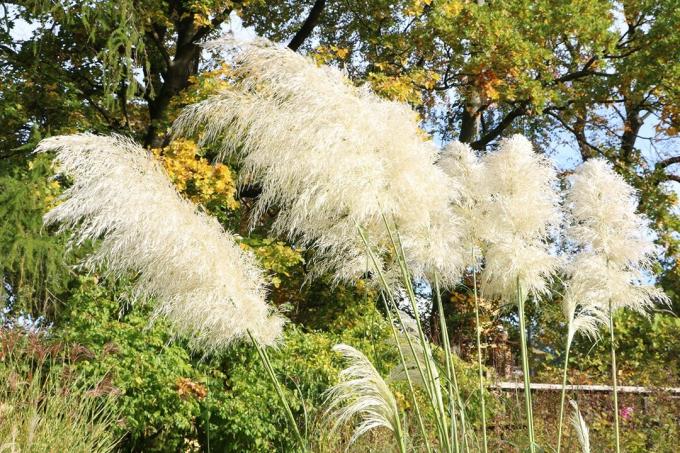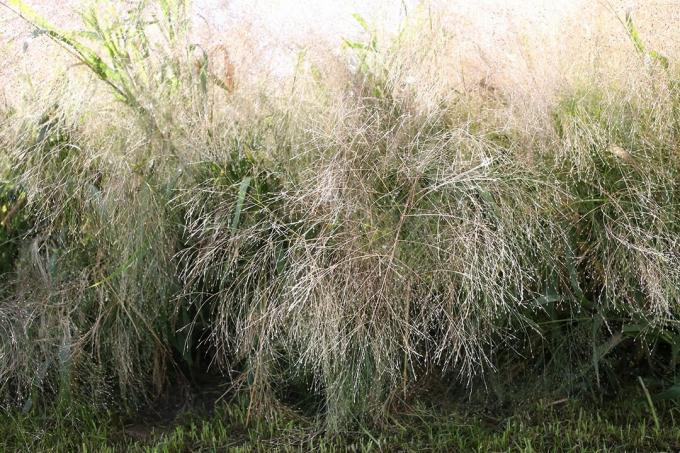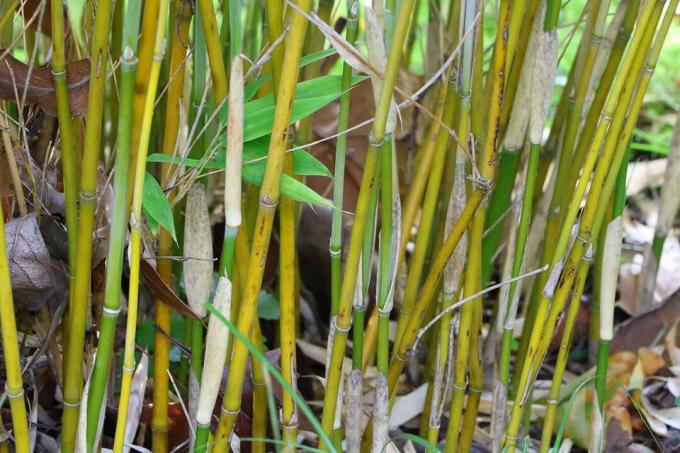

Table of contents
- Why cut back grass?
- Choosing the right time
- The best tool
- Cut deciduous grass properly
- Cut evergreen grass
- Cut very large grass
- Comb, pull and pluck
- Cut back ornamental grass in the tub
- prevent self-seeding
- Dispose of clippings
- Fertilize after cutting
- Increase and rejuvenate after pruning
Cutting grass takes a certain amount of work and time. However, this care measure can be made much more effective and pleasant with certain tricks - you can find out here what these are!
Why cut back grass?
Numerous grasses benefit from an annual cut, whereby this is mainly due to deciduous grasses (e.g. e.g.: pampas grass, Chinese reed or lamp cleaner grass) is very beneficial. The reasons for this vary, with the following factors in particular advocating an annual cut:
- Denser and more lush growth
- Avoiding natural propagation
- Extension of lifespan
- limitation of growth height
Tip:
Some ornamental grasses can reach a height of up to three meters.
Choosing the right time
Grasses should never be cut haphazardly throughout the year as this could damage the plants and impede their growth. Instead, it is advisable to trim the grass in the spring - with a date between February and April being best. While it's tempting to prune dead stalks in the fall, there are several reasons not to do so:
- Culms provide frost protection for roots
- They serve as winter protection for small animals
- Provide winter food and nesting material for birds
- Privacy protection is retained
- Avoidance of rot
Most ornamental grasses are hardy and can cope well with the winter conditions in local regions. However, a cut in autumn would expose the root area and thus remove the natural winter protection. It should not be forgotten that water can penetrate more easily into cut stalks and thus increase the risk of rot. For these reasons, we do not recommend pruning in the fall.
The best tool
Cutting grass involves work and time - but choosing the right tool can make the maintenance much more effective and easier. In any case, it is advisable to wear gloves and long-sleeved clothing, as the sharp-edged straws can certainly lead to injuries. The cutting tool itself should always be disinfected and sharp and adapted to the respective grass species:
- Low grass and small areas: Secateurs with long handles
- Larger grass: pruning shears
- Thick stalks: electric hedge trimmers
A notice:
Some grasses are not cut but simply "combed" with a small rake or multi-pronged claw.
Cut deciduous grass properly

Deciduous grasses (eg. e.g. pampas grass, Chinese reed and fountain pennisetum) cope very well with pruning measures, which is why a proper pruning in spring has proven itself for them. It is worth paying attention to the following:
- Cut grass back to 10-20 cm
- Above the neck or halfway
- Do not damage newly sprouted stalks
- Remove the cut stalks with a leaf rake
Cut evergreen grass
In contrast to deciduous grasses, evergreen grasses do not benefit from severe pruning because this does not stimulate their growth. Instead, a care cut is recommended for them, in which only as much is cut as is actually necessary.
- Remove leaf tips damaged by frost
- Remove dead stems
Cut very large grass
Some grasses grow very tall and lush, which can sometimes make cutting difficult. In addition, the stubborn stalks are associated with an increased risk of injury. In order to effortlessly prune very tall specimens, it is worth tying them together in small bundles and then shortening them as follows:
- Start from the outer edge
- Hold stalks together for cutting
- Don't cut too low
Comb, pull and pluck
Not all grasses undergo pruning, as many can be controlled by combing, pulling, and plucking. These varieties include blue fescue, feather and bearskin grass, but also bamboo, blue grass and sedge. Instead of trimming them with sharp cutting tools, they can be thinned out with simple manual work:
- Comb the grass with your hands
- Pull out old stalks
Tip:
With a simple trick, hobby gardeners can determine whether they need a cutting tool or not: give the stalks with a slight pull, they can be plucked - if not, then a special tool is recommended for this.
Cut back ornamental grass in the tub
Ornamental grass does not only look good in the garden at home, but also in tubs. It should be noted, however, that they are less hardy than outdoor grasses. For this reason, ornamental grass in tubs should always be overwintered in a frost-free area. Pruning measures are also recommended for them, whereby hobby gardeners have more leeway in terms of the right time:
- Before relocating in the fall
- during hibernation
- In the spring

prevent self-seeding
Some types of grass (eg. e.g. flat ear grass or hair grass) can multiply by self-sowing and thus take over the garden in a very short time. However, this can be avoided by specifically preventing seed formation. The best way to do this is to remove the flower spikes just before the seeds ripen. For this reason, in this case, it is advisable to cut off the inflorescences in the fall.
Dispose of clippings
The cuttings can be disposed of in many ways, such as in the bio bin or at a special disposal site. However, it is even better to dispose of the clippings in the compost and thereby create an organic fertilizer for all kinds of plants in the home garden.
- Put clippings (if possible) in the shredder
- The attack surface for microorganisms is increased
- This speeds up rotting
- Mix with fresh soil and moist compost
- This creates valuable hummus
Fertilize after cutting
After cutting, it is advisable to lightly fertilize ornamental grasses with an organic fertilizer (e.g. B.: compost or rock flour) to fertilize. On the one hand, the additional nutrients give them more vitality and, on the other hand, soil fatigue is eliminated - factors that promote their growth and thus lush sprouting.
Increase and rejuvenate after pruning
Ornamental grasses can easily be propagated by division, although the best time to do this is after pruning. All you need is a spade or a digging fork, with which the root ball is divided as follows:
- Dig up ornamental grasses
- Uncover the root ball with a spade or digging fork
- Separate the root ball with a courageous groundbreaking
- Then plant again immediately
- Use as close to the ground as possible
A notice:
A division is ideal for rejuvenating old and bare ornamental grasses!
 garden editorial
garden editorial I write about everything that interests me in my garden.
Learn more about ornamental grasses

cutting bamboo | When and how to cut back bamboo?
Be it as a hedge, solitaire or ground cover, bamboo can be seen more and more often in home gardens. Because the sweet grass is easy to care for and easy to grow. However, the latter can quickly become a problem if the plants are not pruned regularly.

Switchgrass, Panicum virgatum: Care from A – Z
Switchgrass is an upright-growing, clump-forming grass with narrow leaves. The species is considered to be easy to care for and makes few demands on location and soil. Read how to optimally plant and care for Panicum virgatum.

Zebra grass, Miscanthus sinensis 'Strictus': care from A - Z
In botanical jargon, zebra grass is also called Miscanthus sinensis 'Strictus'. The plants can be used wonderfully as privacy screens and are decorative. From care in the tub to overwintering: You can find information on care from A - Z here.

Grow pampas grass from seeds: we explain how
Pampas grass is considered easy to cultivate and can be successfully propagated by breeding. Under controlled conditions in the planter, the germination success is higher than with direct outdoor sowing. The procedures regarding substrate, choice of location and care hardly differ in these variants.

Grasses as a privacy screen: 20 tall grasses
Numerous grasses are ideal as privacy screens! We present the 20 most popular grasses in this article!

Grasses for the balcony | 21 hardy ornamental grasses
Grasses are comparatively easy-care and undemanding plants that can also be suitable for the balcony. But which ornamental grasses are these and which hardy species are available? Our overview will help.
